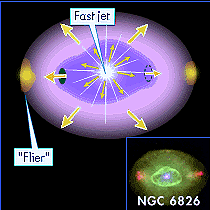Astronomers will release today the clearest images yet of FLIERS, mysterious cosmic spouts
By Blaine Friedlander


Astronomers will release today (Dec. 17) the clearest Hubble Space Telescope images of mysterious cosmic spouts -- known as FLIERs -- emanating from distant objects that once were stars like our sun.
FLIERs, an acronym for "Fast, Low Ionization Emission Regions," are red in color and bolt out from planetary nebulae -- clouds of ejected material from sunlike, old stars in the process of dying and exploding -- at supersonic speeds.
"They shoot out from the nebulae, but we don't know if the FLIERs shoot out from the polar axis direction of the nebulae or from the equatorial plane of the nebulae," said Yervant Terzian, the James A. Weeks Professor of Physical Sciences and chair of Cornell's astronomy department. Terzian is one of a team of astronomers credited with taking some of the Hubble Space Telescope images being released today.
Nine never-before-seen images are being presented to the public at a press conference in Baltimore, home of the Space Science Telescope Institute, Dec. 17 at 1 p.m.
One of the interstellar images will be of an object called NGC 6826, nicknamed the Blinking Planetary nebula, because of its green, eyelike appearance. The Blinking Planetary features a set of FLIERs squirting horizontally from the nebula.
The picture of the Blinking Planetary nebula was taken by the Hubble Jan. 27, 1996, and the estimated distance from the telescope to the nebula is about 0.7 kiloparsecs or 2,200 light-years. (To reach the nebula, it would take 2,200 years, traveling at the speed of light.)
The parent star evolved into a "red giant," after existing as a normal star for about 8 billion years. As its existence as a "red giant" ended a few thousand years ago, the star began to spew its upper mantles at relatively low speeds of about 30 kilometers per second. (Supernovae, resulting from more massive stars, explode and throw off ejecta at speeds of up to thousands of kilometers per second.)
"In 3 or 4 billion years, our sun is going to do the same thing," Terzian said. "When it does, even the Earth and Mars will be engulfed."
Terzian explained that FLIERs likely are made mostly of nitrogen and are low ionization material blobs that are being shot out of the nebulae in a symmetrical pattern. Previously, nebulae and their FLIERs could be seen from ground-based telescopes with limited clarity. Until now, no one had seen FLIERs with the high resolution and detail revealed in the Hubble Telescope pictures the astronomers are releasing today.

Astronomy is relatively new to the study of FLIERs, which apparently are a byproduct of exploding stars. Astronomers describe FLIERs as sparks shooting from a star late in the relatively recent past, about a 1,000 years ago.
The Hubble Space Telescope's Blinking Planetary image credit goes to astronomers Bruce Balick of the University of Washington (Cornell Ph.D '71); Jason Alexander, University of Washington; Arsen Hajian, U.S. Naval Observatory, Washington, D.C. (Cornell Ph.D. '95); Mario Perinotto, University of Florence (Italy); Patrizio Patriarchi, Arcetri Observatory (Italy); and Cornell's Terzian, who used a special instrument with the Hubble Telescope known as WFPC2 (pronounced "wiffpick two"). Balick was one of Terzian's first graduate students, and Hajian was one of his most recent.
The same group of astronomers is credited with developing three more of the nine images being released today. Object NGC 7009, which also shows very prominent FLIERs, nicknamed the Saturn Nebula, was observed by the Hubble Space Telescope April 28, 1996, and is one of the images being released. Astronomers believe the distance from here to the Saturn Nebula is 0.42 kiloparsecs or 1,400 light-years.
Over the next few years, the Hubble Space Telescope will take new images of the objects. From these periodic observations, astronomers will be able to accurately deduce the distances from here to the nebulae, thus giving us a true feeling for the total energy involved in these explosions.
Even for a professional astronomer, Terzian says, the Hubble Space Telescope's clear images are astounding. "If we were to use the best ground-based optical telescopes, it would take us many tens of years to do this work. And without the best telescopes, it would take us 100 years to determine the distances and deduce the energies involved," he said.
For the Blinking Planetary, Terzian expected to see an amorphous stellar envelope. "I was surprised by the symmetry I saw," he said. "That tells us something about the physics of the stellar explosion. It is really difficult to do detective work from such an enormous distance."
Media Contact
Get Cornell news delivered right to your inbox.
Subscribe